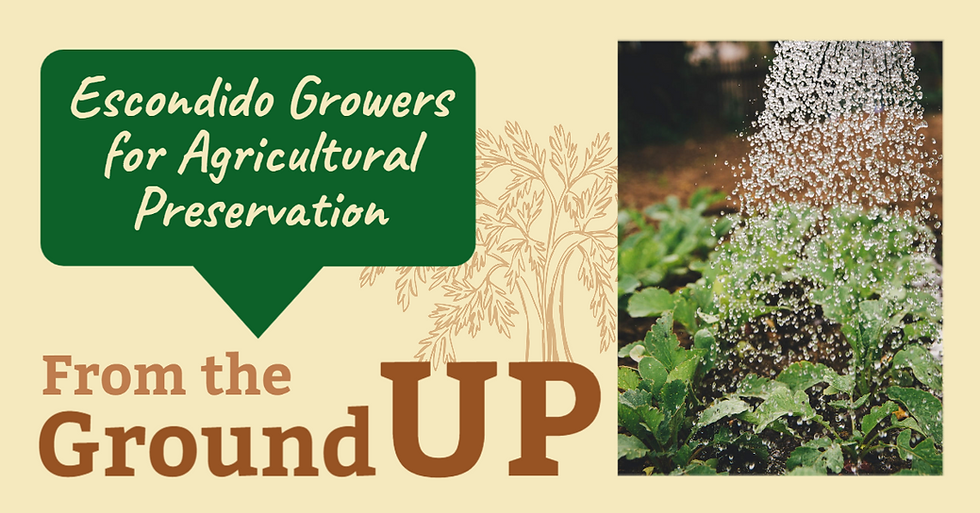A Profile on the Legacy of Escondido Agriculture: Part 2
- Climate Science Alliance

- Jul 6, 2020
- 5 min read
Our next profile in the “From the Ground Up” series is a two-part story on the historical legacy of agriculture in Escondido and the importance of preserving this legacy into the future. Today, in Part 2 of the series, we hear from the co-directors of the Escondido Growers for Agricultural Preservation (EGAP), Edward Grangetto and John Burr, on how Escondido agriculture’s historical legacy shapes the region’s agriculture today, its importance for Escondido’s economy, community, environment, and regional climate solutions, and the role of EGAP in promoting sustainable and thriving agriculture for the future.

As part of the on-going efforts of the 2020 Climate Change Consortium, hosted in partnership by the Climate Science Alliance and the California Department of Food and Agriculture, we are excited to share a series of producer stories, called “From the Ground Up: Farmer Profiles,” highlighting our region’s producers and the important work they do for our communities.
Our next profile in the “From the Ground Up” series is a two-part story on the historical legacy of agriculture in Escondido and the importance of preserving this legacy into the future. Today, in Part 2 of the series, we hear from the co-directors of the Escondido Growers for Agricultural Preservation (EGAP), Edward Grangetto and John Burr, on how Escondido agriculture’s historical legacy shapes the region’s agriculture today, its importance for Escondido’s economy, community, environment, and regional climate solutions, and the role of EGAP in promoting sustainable and thriving agriculture for the future. To read Part 1, click here.

What are the benefits of agriculture for the environment, community, and economy of Escondido?
“The beneficial impact from agriculture on greenhouse gas and climate change includes sustainability options that include economic, environmental and social (practices such as improving supply chains, more local food production, using data analysis for ‘on farm decisions’, measuring environmental performance with grower’s potential business opportunities and an emphasis on a reduction in fossil energy use.)"

“Agriculture not only provides a huge part of Escondido’s heritage and image, it also provides a multitude of environmental benefits such as:
Carbon offsets
A barrier for wildfires
Habitat for many species
Local food security
Escondido agriculture image of sustainability
Recycling of Escondido wastewater
"Local agricultural lands and orchard crops provide many ecosystem services while also playing an important role in our region’s climate solutions. From sequestering carbon, buffering the impacts of extreme events and storms, regulating temperatures and air quality, supplying habitat for wildlife, and utilizing sustainable water resources, local agriculture can help ensure a resilient region for the years to come."

“Additionally, the continued importance of a thriving agricultural sector is underscored by the enormous financial offering that our various agricultural businesses provide. Agriculture contributes over $240 million (as of 2012) to the City of Escondido economy and supports between 2,000 and 3,000 jobs. Escondido Agriculture Ag Tech was listed as a key player (Strategic Prioritization and Recommended Initial Strategic Focus) regarding the efforts to develop reclaimed water for agriculture and for retention/expansion in Escondido Comprehensive Economic Development Strategy (CEDS) 2012 and 2018."

“The rewards associated with agriculture also include the provision of ecosystem services, such as the aesthetic attributes associated with open and green space along with the commodity support of local food distribution.”

What do you see as the greatest challenges for the region’s growers, and in general, for agriculture, now and in the future?
“Sustainable water for agriculture at a price point that allows growers to have a profitable business model.”
Describe the role that EGAP plays for Escondido agriculture.
"EGAP has been the vehicle that not only brought the concept of wastewater to agriculture, allowing Escondido to avoid a billion-dollar liability with their ocean outfall, but also has tirelessly created strategic initiatives for the City to keep agriculture viable, such as:
Focus and commitment of EGAP
The marriage of agriculture and recycled water
Sustainable water pricing for growers
Persevering the agriculture cluster
An Agricultural Summit that attracted over 100 local participants including Escondido Council personnel and Supervisor Bill Horn
EGAP Water Documentary
A written document (Agriculture in Escondido, Contributions, Challenges, Opportunities) that provides factual information regarding Escondido’s agricultural economy
Evaluation of Recycled Water for Avocado Irrigation Final Project Report, January 2016 by Jenessa Stemke (Results of a local Avocado Irrigation Trial)
A website to allow all citizens to follow EGAP’s progress
EGAP Article in Escondido Magazine, Fall 2012
EGAP worked with the Escondido City Council to avoid a 12% rate increase in water costs to Growers for 2012"

Why do you think organizations like EGAP are important for Escondido Agriculture?
“Organizations such as EGAP are important for Escondido Agriculture in a multitude of ways. EGAP allows for a collective voice from local growers that can be focused for key issues, such as the development of a sustainable recycled water source that provides a vehicle for the City to avoid a potential $1 billion liability. Only by the creation of EGAP did Escondido find an elegant and long term solution to its wastewater disposal dilemma.
“EGAP is dedicated to the preservation of our agricultural heritage for all Escondido Citizens through the use of renewed water resource management that meets the evolving business needs of growers and the community. This includes a number of agriculture-related businesses (eg. Pauley Equipment, Shuster Oil, Henry Avocado, etc.), to ancillary affiliations such as Eco Life and the Children’s Discovery Museum to colleges and animal feed companies, such as; Vitagold Brands Co-op Association. EGAP also welcomes any person or organization that may contribute to the improvement of our City.
“The capability of a single organization to put together a project (such as “Defining Recycled Water Quality for Optimal Avocado Production in Escondido”) and bring together participants from the University of California Riverside, Cooperative Extension UC Personnel, SD County Farm Bureau and the City of Escondido and produce a Master’s Thesis Report that provided an experimental Avocado Trial on an EGAP member’s property, our grassroots effort to advance local agriculture continues today. In a nutshell, EGAP has been the impetus for the City of Escondido to embark on the largest Public Utilities Project in its history and in the process, saving agriculture from an early demise.”

What do you envision for the future of Escondido agriculture? What do you think it will take to get there?
“The future of Escondido agriculture will likely be an amalgam of larger enterprises that include avocados, nurseries and various tree and vine crops, etc. that depend on lower cost water to thrive. Additionally, specialty crops such as hemp, herbs, vineyards, greenhouse vegetables and aquaculture may become more popular for a variety of reasons. Ag Tech may also arrive. With the emphasis on Escondido as an “Agricultural Hub,” the opportunity for our city to become an “incubator” of agriculture- related business possibilities is endless."

“If we follow the definition of sustainability (sustainability is about the current and future well being of the system as a whole), Escondido is poised to have a “self-contained” community that is well supported by agriculture and a sustainable water supply of recycled water for growers. Further, organizations such as “Eco Life” save resources with aquaponics, community based construction and providing solutions to animal extinction and human health issues by addressing problems at their common roots.
"The path to all of these key elements is with the help of the city leaders. Local agriculture needs a permanent seat on a commission or board of the City of Escondido and this would allow all the citizens of our city to benefit from the energy of local agriculture.”
To learn more about EGAP and their on-going efforts to support Escondido Agriculture, visit: http://growescondido.org/. To read more about the benefits of local agriculture for our region’s climate, community, and economy, visit: www.climatesciencealliance.org/resilient-roots-resources
Stay tuned in the coming months as we share these stories and for more information, visit:
Agriculture in Escondido: Opportunities for Resilience - to learn more about agriculture in Escondido, created in collaboration with EGAP
2020 Climate Change Consortium for Specialty Crops Southern California - for additional project information and to access all materials, resources, and surveys.
From the Ground-Up: Farmer Profiles - to hear stories from other producers
Climate Science Alliance - to learn more about our work and other projects




